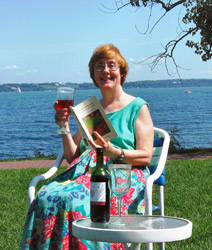Writer Patricia Roth Schwartz blogs about facilitating a P&W-supported workshop series at the Terwilliger Museum in Waterloo, New York.
A graceful Queen Anne structure, the Waterloo Library & Historical Society, which opened in 1880, is the first building in New York State built as a library. In 1960 a local businessman donated funds to open an attached museum of Waterloo history, which bears his name: Terwilliger. The Terwilliger Museum’s a spooky place. It is low-ceilinged, dim, and its two floors are partitioned into several areas filled with antique dolls, guns, china, vintage fire-fighting equipment, musical instruments, Native American artifacts, and the replicated interiors of both a pioneer cabin and a country store.
 I’d written a grant proposal to Poets & Writers for a three-week workshop: Writing Your Way Through History, the first program ever held in the museum. I showed up at the appointed time, fully expecting no one to be there. In semi-rural areas, the hardest aspect of putting on an event is publicizing it, and we hadn’t done much. Even so, right on the dot, several people climbed the stairs to meet me. A short while later a few others arrived. In all, seven people attended at least part of the program, including a fourth-grader, granddaughter of a Terwilliger Museum member. Armed with a sheet of writing prompts I’d given them, participants explored the museum, searching for characters and stories amongst the museum’s holdings. After an hour, we retired to a cozy nook with tables and chairs in the library adjacent to the museum, an ideal writing space.
I’d written a grant proposal to Poets & Writers for a three-week workshop: Writing Your Way Through History, the first program ever held in the museum. I showed up at the appointed time, fully expecting no one to be there. In semi-rural areas, the hardest aspect of putting on an event is publicizing it, and we hadn’t done much. Even so, right on the dot, several people climbed the stairs to meet me. A short while later a few others arrived. In all, seven people attended at least part of the program, including a fourth-grader, granddaughter of a Terwilliger Museum member. Armed with a sheet of writing prompts I’d given them, participants explored the museum, searching for characters and stories amongst the museum’s holdings. After an hour, we retired to a cozy nook with tables and chairs in the library adjacent to the museum, an ideal writing space.
Everyone was busy except Mary Alice, a feisty, intelligent woman in her 70s who used to write a column for a local paper but stopped. She’d been suffering from writer’s block, she told me, but arrived to the workshop with a brand new baby blue journal. Now she sat frozen before a blank page. I walked up to her and asked quietly, "Who's your character?" "Grandma," she said. "Okay–What's happening? Tell the story," I eagerly replied. A heartbeat passed. Her pen rose to the page. "It's Midge." And out the story poured. Inspired by the exhibit of a 1920s dressed mannequin doing laundry on a washboard in a galvanized tub, Mary Alice told the story of tomboy "Midge" (herself), getting her clothes dirty and "Grandma," instead of getting mad, simply offering, "I'll teach you how to wash them."
Everyone else in the group (as if by some alchemical change that affected them all simultaneously) wrote astonishingly excellent stories, each set in an historical context. Eagerly they read aloud to each other. By the end of our sessions, a writers’s group of five of the attendees had formed and continues to meet, planning a blog and a chapbook to showcase their work. Best of all, Mary Alice called to tell me she’d resumed writing her column and even received a raise in pay for it!
Photo: Patricia Roth Schwartz. Credit: Sandy Zohari.
Support for the Reading/Workshops in New York is provided, in part, by public funds from the New York State Council on the Arts, with additional support from the Friends of Poets & Writers.







